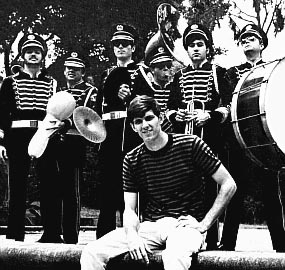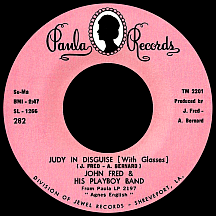JOHN FRED AND HIS
PLAYBOY BAND
Judy in Disguise (With Glasses)
Mop Top ripoff alert! John Fred and his Playboy partner-in-crime, Andrew Bernard, penned one of the more convoluted musical caricatures of any Beatles song, taking the already intriguingly abstract "Lucy in the Sky With Diamonds" and giving it a totally new melody with mostly-different lyrics (no plagiarism here, not really!) while delivering an end product unmistakably derived from its source material. The lyrics of "Judy in Disguise (With Glasses)" seem slapped together (amateurishly so in some spots; 'marshmallow pies' in the original became 'lemonade pies' in John Fred's song with 'kaleidoscope eyes' awkwardly altered to 'cantaloupe eyes'), but in looking beyond the imitation game (and with the help of explanations from Fred in various interviews), there is a character-driven story, however silly, that can be extracted from the song.
While gazing at suntanned beach babes one summer afternoon, the Fredster noticed a trend: large sunglasses that, upon closer inspection and removal of said shades, revealed faces that he claimed "...could stop a clock!" So there you had justification for the "disguise" and with "Lucy" providing inspiration, the lines of his song began to fall into place: 'A-cross your heart, yeah, with your livin' bra' (taken from a Playtex boulder-holder, ahem, undergarment commercial) took focus away from facial features and 'A-circus of a-horrors...' drove home the point in a Beatlesque way for those inclined towards developing their own theories. The arrangement, all horns and strings and an infectious bass line with some oddly-placed moans and groans, makes it all add up to a peculiar-but-catchy late-'60s hit. As for my tongue-in-cheek "ripoff" allegation, well, who didn't "borrow" ideas from the Beatles in those days?
About the only obvious thing Baton Rouge, Louisiana has in common with Liverpool, England is its adjacency to the Mississippi River (the latter straddles the River Mersey). John Fred Gourrier, his ancestry French like so many in the Pelican State, was drawn to a career in music at age 12 when he heard Fats Domino's 1953 hit "Going to the River." He formed a band a few years later (bassist and eventual teen singer Ike Clanton was a member) that became John Fred and the Playboys, named after a predictable fascination he had with Hugh Hefner's recently-established Playboy magazine. Slippin' on down to New Orleans, John managed to squeeze himself through the doors of Cosimo Matassa's infamous French Quarter studio where Domino had just wrapped a recording session (Fats' hit "Whole Lotta Lovin'" came out of that September 1958 studio jam). With backup from Domino's session players (saxophonist Clarence Fox, guitarists Walter Nelson and Ernest McLean, bassist Frank Fields and drummer Charles Williams), the lucky Gourrier recorded a couple of songs including "Shirley," an uptempo tune he'd written with another Playboys band member, Tommy Bryan.
The R&B-tinged rock and roll song ('I called Shirley's mama on the phone, she said Shirley's not at home...she said my little girl oughta be back soon...she's gone on a honeymoon...') found a home on Sam Montalbano's Montel label; it worked its way through the south and on a handful of radio stations around the country, which led to a guest spot for Fred's band on Alan Freed's TV show The Big Beat on New York's WNEW, which helped boost it onto the national charts for several weeks in the winter and spring of 1959. Another single on Montel, the softer-rocking "Mirror, Mirror (On the Wall)" (featuring Elvis's backing singers The Jordanaires), hinted at a maturity and depth of talent the just-turned-18-year-old possessed. "Good Lovin'," released in the spring of 1960 as a solo John Fred record, compared favorably to the works of Texas rockers like Buddy Holly and Buddy Knox while retaining the sax-based Louisiana flavor. Fred entered Southeastern Louisana University that fall and waxed one final Montel single with the Playboys, "Down in New Orleans," before putting his music career on hold to focus on playing basketball and baseball for the school while continuing his studies through 1963.

Fred formed a new group of Playboys with saxophonist Andrew Bernard and signed with Jewel, a startup run in Shreveport by Stan Lewis that ultimately had success with blues and R&B artists. "Dial 101 (Cause I Still Love You)" (composed by Ike's singing star brother Jimmy Clanton), "You're Mad at Me," "Wrong to Me" and Presley favorite "Boogie Children," the last three written by Fred and/or Playboys guitarist Lynn Ourso, all varied stylistically. In '65, Lewis switched the act over to his Paula label and they began recording at Robin Hood Studios, about a hundred miles away in Tyler, Texas (a Shreveport-based band on Paula, The Uniques, did their best work there and had just hit the charts with "Not Too Long Ago"). The strong, diverse but non-hit string of releases continued under a voluntarily adjusted name, John Fred and his Playboy Band, as a certain amount of confusion with the extremely popular Gary Lewis and the Playboys had occurred. When John and Andrew began writing together, lyrics took on a curious complexity while the music had an updated, '60s-style rock vibe. "Up and Down," a 45 from early '67, showed promise. The band's least-Louisianan-leaning track yet, "Agnes English" ('She owns a house on Carnaby Street'...hints were a-plenty as to what might be going on inside!), popped up on Billboard's "Bubbling Under" list, J.F.'s first appearance on a national chart in eight years.
Then June 1967 rolled around and Sgt Pepper's Lonely Hearts Club Band set the world a-buzzin', "Lucy" and her diamonds morphed into "Judy" wearing her glasses ('Come to me tonight'...and leave the Ray-Bans on, please!) and this wildly unusual recording caught on as John Fred worked his way to number two in January '68 behind the Beatles' "Hello Goodbye" before knocking his distant mentors off the top spot. "Judy in Disguise (With Glasses)" made stars of John Fred and his Playboy Band, if only for a short time, but it solidifed their superstar status within the Louisiana border and parts of the surrounding region, a distinction that fed John's creative streak for many years.
There was another national chart single, "Hey, Hey, Bunny" (the pattern had been established; unexplained lines like 'Her picture's on the front page, y'all, she finally made the news' kept fans guessing). "We Played Games" made a small impact at radio that spring, then in '69 the band jumped over to the Uni label for about a year. By 1973, John was recording for Bell Records with another group, The Creepers. Later he set up shop in Baton Rouge as a record producer; in 1979, with regional music-and-media mini-mogul Cyril E. Vetter, he produced "Safe With Me" for New Orleans Soul Queen Irma Thomas. For the next couple of decades John Fred sang TV commercial jingles, occasionally put out records and performed for audiences on a regular basis, making the most of his famous, fab creation, the unzippered specs-wearing cantaloupe-camouflage giant Judy-whoever on the beach...or in the sky with...?


